Ashutosh Chaubey
Face-LLaVA: Facial Expression and Attribute Understanding through Instruction Tuning
Apr 09, 2025



Abstract:The human face plays a central role in social communication, necessitating the use of performant computer vision tools for human-centered applications. We propose Face-LLaVA, a multimodal large language model for face-centered, in-context learning, including facial expression and attribute recognition. Additionally, Face-LLaVA is able to generate natural language descriptions that can be used for reasoning. Leveraging existing visual databases, we first developed FaceInstruct-1M, a face-centered database for instruction tuning MLLMs for face processing. We then developed a novel face-specific visual encoder powered by Face-Region Guided Cross-Attention that integrates face geometry with local visual features. We evaluated the proposed method across nine different datasets and five different face processing tasks, including facial expression recognition, action unit detection, facial attribute detection, age estimation and deepfake detection. Face-LLaVA achieves superior results compared to existing open-source MLLMs and competitive performance compared to commercial solutions. Our model output also receives a higher reasoning rating by GPT under a zero-shot setting across all the tasks. Both our dataset and model wil be released at https://face-llava.github.io to support future advancements in social AI and foundational vision-language research.
DiTaiListener: Controllable High Fidelity Listener Video Generation with Diffusion
Apr 05, 2025Abstract:Generating naturalistic and nuanced listener motions for extended interactions remains an open problem. Existing methods often rely on low-dimensional motion codes for facial behavior generation followed by photorealistic rendering, limiting both visual fidelity and expressive richness. To address these challenges, we introduce DiTaiListener, powered by a video diffusion model with multimodal conditions. Our approach first generates short segments of listener responses conditioned on the speaker's speech and facial motions with DiTaiListener-Gen. It then refines the transitional frames via DiTaiListener-Edit for a seamless transition. Specifically, DiTaiListener-Gen adapts a Diffusion Transformer (DiT) for the task of listener head portrait generation by introducing a Causal Temporal Multimodal Adapter (CTM-Adapter) to process speakers' auditory and visual cues. CTM-Adapter integrates speakers' input in a causal manner into the video generation process to ensure temporally coherent listener responses. For long-form video generation, we introduce DiTaiListener-Edit, a transition refinement video-to-video diffusion model. The model fuses video segments into smooth and continuous videos, ensuring temporal consistency in facial expressions and image quality when merging short video segments produced by DiTaiListener-Gen. Quantitatively, DiTaiListener achieves the state-of-the-art performance on benchmark datasets in both photorealism (+73.8% in FID on RealTalk) and motion representation (+6.1% in FD metric on VICO) spaces. User studies confirm the superior performance of DiTaiListener, with the model being the clear preference in terms of feedback, diversity, and smoothness, outperforming competitors by a significant margin.
ContextIQ: A Multimodal Expert-Based Video Retrieval System for Contextual Advertising
Oct 29, 2024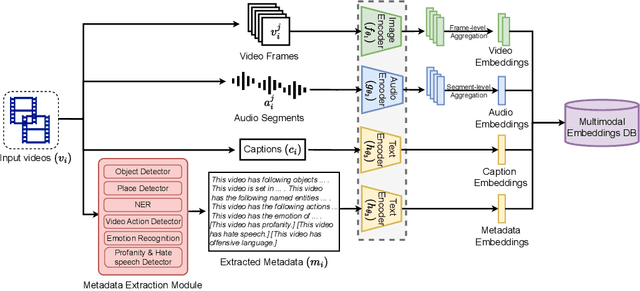

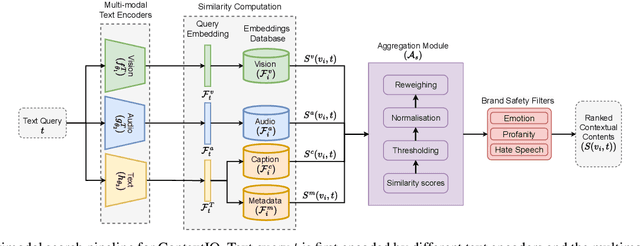
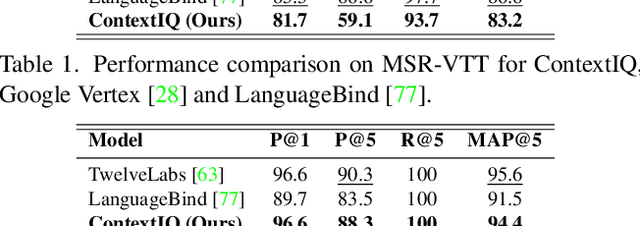
Abstract:Contextual advertising serves ads that are aligned to the content that the user is viewing. The rapid growth of video content on social platforms and streaming services, along with privacy concerns, has increased the need for contextual advertising. Placing the right ad in the right context creates a seamless and pleasant ad viewing experience, resulting in higher audience engagement and, ultimately, better ad monetization. From a technology standpoint, effective contextual advertising requires a video retrieval system capable of understanding complex video content at a very granular level. Current text-to-video retrieval models based on joint multimodal training demand large datasets and computational resources, limiting their practicality and lacking the key functionalities required for ad ecosystem integration. We introduce ContextIQ, a multimodal expert-based video retrieval system designed specifically for contextual advertising. ContextIQ utilizes modality-specific experts-video, audio, transcript (captions), and metadata such as objects, actions, emotion, etc.-to create semantically rich video representations. We show that our system, without joint training, achieves better or comparable results to state-of-the-art models and commercial solutions on multiple text-to-video retrieval benchmarks. Our ablation studies highlight the benefits of leveraging multiple modalities for enhanced video retrieval accuracy instead of using a vision-language model alone. Furthermore, we show how video retrieval systems such as ContextIQ can be used for contextual advertising in an ad ecosystem while also addressing concerns related to brand safety and filtering inappropriate content.
Speaker-specific Thresholding for Robust Imposter Identification in Unseen Speaker Recognition
Jun 01, 2023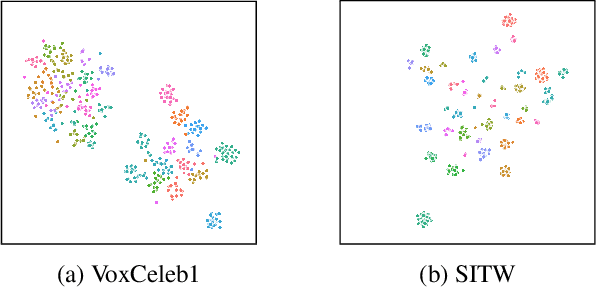

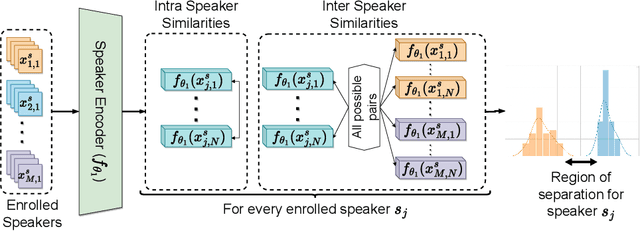

Abstract:Speaker identification systems are deployed in diverse environments, often different from the lab conditions on which they are trained and tested. In this paper, first, we show the problem of generalization using fixed thresholds computed using the equal error rate metric. Secondly, we introduce a novel and generalizable speaker-specific thresholding technique for robust imposter identification in unseen speaker identification. We propose a speaker-specific adaptive threshold, which can be computed using the enrollment audio samples, for identifying imposters in unseen speaker identification. Furthermore, we show the efficacy of the proposed technique on VoxCeleb1, VCTK and the FFSVC 2022 datasets, beating the baseline fixed thresholding by up to 25%. Finally, we exhibit that the proposed algorithm is also generalizable, demonstrating its performance on ResNet50, ECAPA-TDNN and RawNet3 speaker encoders.
Improved Relation Networks for End-to-End Speaker Verification and Identification
Mar 31, 2022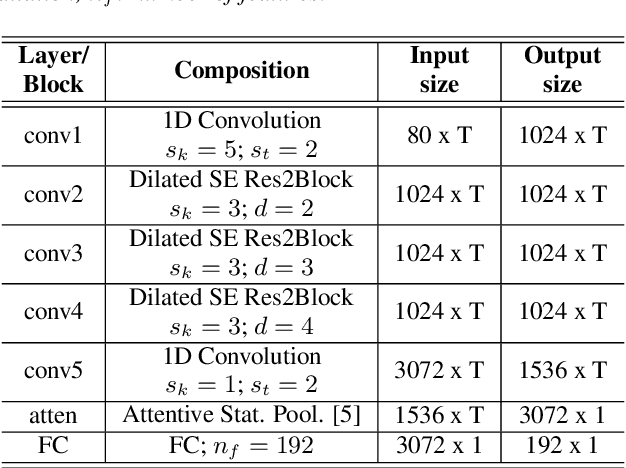
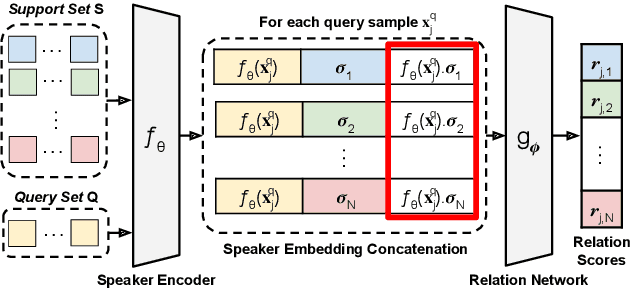
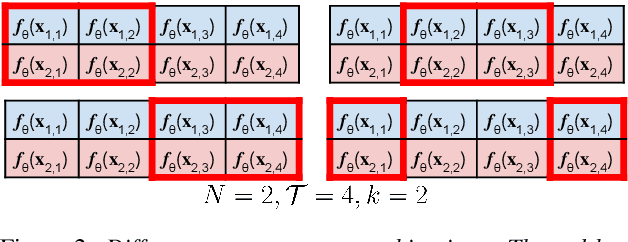
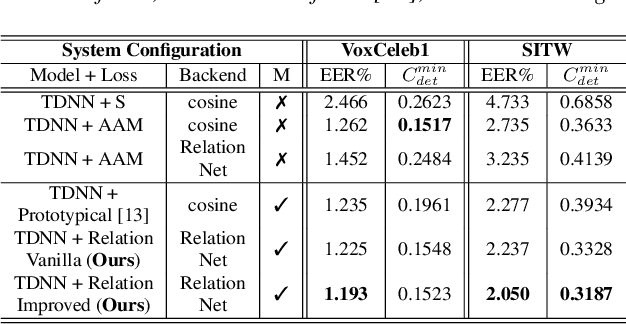
Abstract:Speaker identification systems in a real-world scenario are tasked to identify a speaker amongst a set of enrolled speakers given just a few samples for each enrolled speaker. This paper demonstrates the effectiveness of meta-learning and relation networks for this use case. We propose improved relation networks for speaker verification and few-shot (unseen) speaker identification. The use of relation networks facilitates joint training of the frontend speaker encoder and the backend model. Inspired by the use of prototypical networks in speaker verification and to increase the discriminability of the speaker embeddings, we train the model to classify samples in the current episode amongst all speakers present in the training set. Furthermore, we propose a new training regime for faster model convergence by extracting more information from a given meta-learning episode with negligible extra computation. We evaluate the proposed techniques on VoxCeleb, SITW and VCTK datasets on the tasks of speaker verification and unseen speaker identification. The proposed approach outperforms the existing approaches consistently on both tasks.
OPAD: An Optimized Policy-based Active Learning Framework for Document Content Analysis
Oct 07, 2021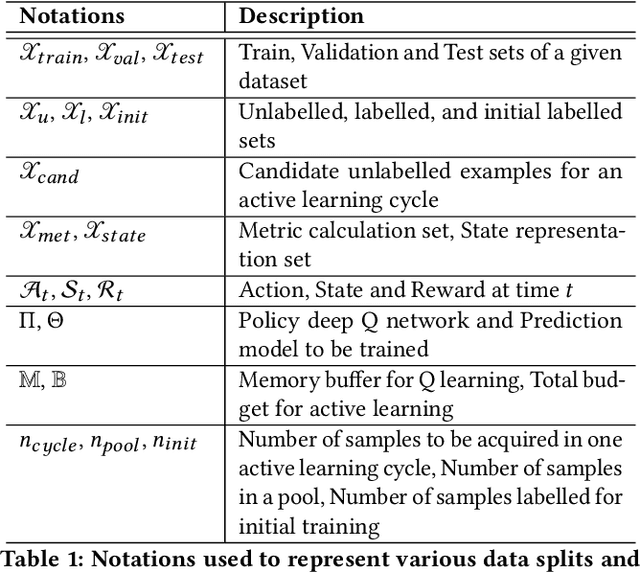
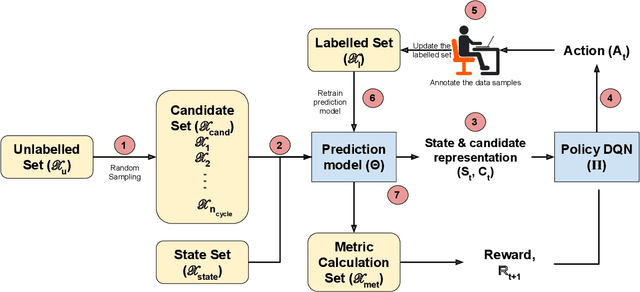
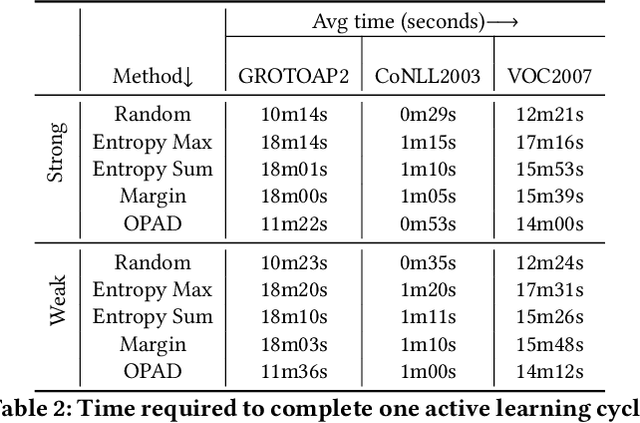
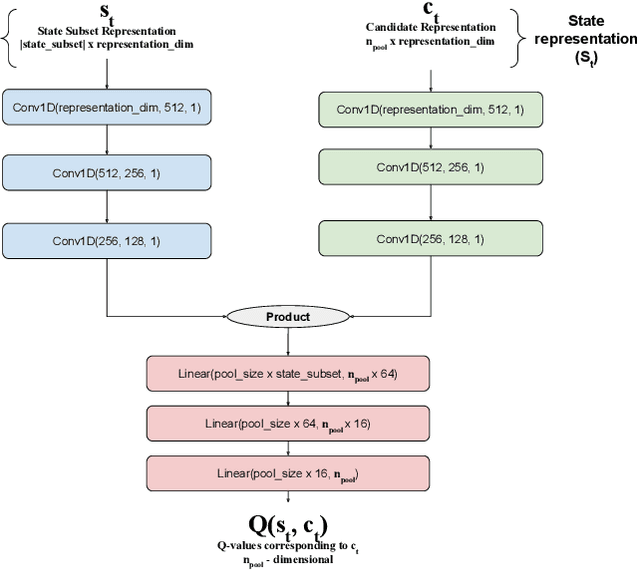
Abstract:Documents are central to many business systems, and include forms, reports, contracts, invoices or purchase orders. The information in documents is typically in natural language, but can be organized in various layouts and formats. There have been recent spurt of interest in understanding document content with novel deep learning architectures. However, document understanding tasks need dense information annotations, which are costly to scale and generalize. Several active learning techniques have been proposed to reduce the overall budget of annotation while maintaining the performance of the underlying deep learning model. However, most of these techniques work only for classification problems. But content detection is a more complex task, and has been scarcely explored in active learning literature. In this paper, we propose \textit{OPAD}, a novel framework using reinforcement policy for active learning in content detection tasks for documents. The proposed framework learns the acquisition function to decide the samples to be selected while optimizing performance metrics that the tasks typically have. Furthermore, we extend to weak labelling scenarios to further reduce the cost of annotation significantly. We propose novel rewards to account for class imbalance and user feedback in the annotation interface, to improve the active learning method. We show superior performance of the proposed \textit{OPAD} framework for active learning for various tasks related to document understanding like layout parsing, object detection and named entity recognition. Ablation studies for human feedback and class imbalance rewards are presented, along with a comparison of annotation times for different approaches.
Universal Adversarial Perturbations: A Survey
May 16, 2020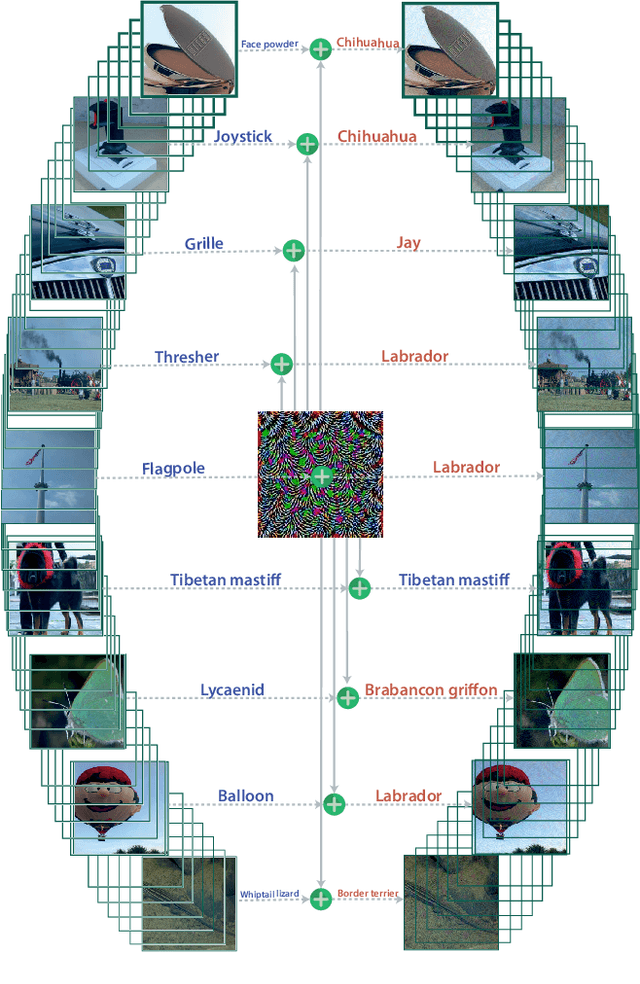

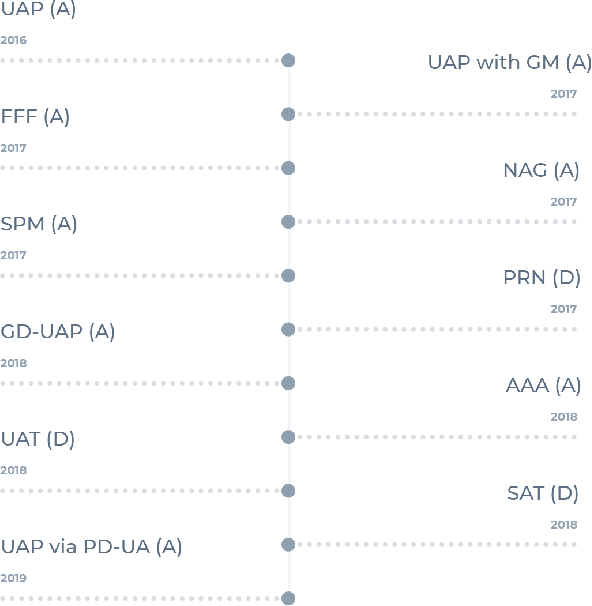

Abstract:Over the past decade, Deep Learning has emerged as a useful and efficient tool to solve a wide variety of complex learning problems ranging from image classification to human pose estimation, which is challenging to solve using statistical machine learning algorithms. However, despite their superior performance, deep neural networks are susceptible to adversarial perturbations, which can cause the network's prediction to change without making perceptible changes to the input image, thus creating severe security issues at the time of deployment of such systems. Recent works have shown the existence of Universal Adversarial Perturbations, which, when added to any image in a dataset, misclassifies it when passed through a target model. Such perturbations are more practical to deploy since there is minimal computation done during the actual attack. Several techniques have also been proposed to defend the neural networks against these perturbations. In this paper, we attempt to provide a detailed discussion on the various data-driven and data-independent methods for generating universal perturbations, along with measures to defend against such perturbations. We also cover the applications of such universal perturbations in various deep learning tasks.
 Add to Chrome
Add to Chrome Add to Firefox
Add to Firefox Add to Edge
Add to Edge